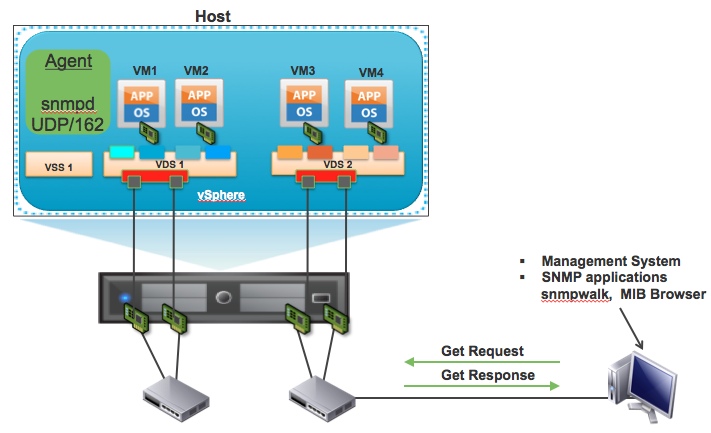In this post, I want to discuss one of the important enhancements in vSphere 5.1. It is obviously related to networking and has to do with providing monitoring support to virtual switch parameters through SNMP. We talked about the RSPAN, ERSPAN capabilities and how you can make use of these features to monitor and troubleshoot any networking issue. Similarly, using the new networking MIBs, you will have the visibility into virtual switches. Here are some of the basics on SNMP before I jump-in and discuss the enhancement in detail.
Simple Network Management Protocol (SNMP) is a standard that allows you to manage devices on IP networks. It consists of three key components: Managed devices, Agent, and Network Management System. In a physical network you will find switches, routers and other networking devices as Managed devices with SNMP Agent running on them. The Agent support on these physical network devices allows a centralized Network Management System (NMS) to get information about these devices and also set parameters centrally.
The information exchange between the Agent and Management System happens through simple get and set commands and SNMP Management Information Base (MIB) format. The Management Information Base (MIB) contains information about managed devices, and it is organized in a hierarchy. There are large numbers of MIBs defined by standards bodies such as IETF and IEEE and there are also proprietary MIBs. Each managed device keeps a database of values for each of the definitions written in supported MIBs.
With server virtualization a new network component, called virtual switch, is introduced in the network infrastructure. The virtual switch has become one of the key networking components of the data center network. Until now, the virtual switch properties were not available through Network Management system. However, with vSphere 5.1 release this is changed.
One thing to note is that the SNMP support on vSphere or ESX platform has been available since the inception of the hypervisor. Along with that SNMP support, VMware proprietary MIB modules are also provided. These MIBs share details about the VMware System and Resources. I am not going to discuss those MIB modules informaiton here. The focus is on the networking related MIB support in vSphere.
The following are some of the networking MIB modules that are supported in vSphere 5.1:
- RFC 2863 IF-MIB (Interface Group MIB)
- IEEE 802.1 BRIDGE-MIB and Q-BRIDGE-MIB
- IEEE 802.3 LAG-MIB and LLDP-V2-MIB
- RFC 4293 IP-MIB
- RFC 4292 IP-FORWARD-MIB
- RFC 4022 TCP-MIB
- RFC 4133 UDP-MIB and ENTITY-MIB
Through these MIB support, network administrators can collect important virtual network data that can help in the monitoring and troubleshooting network issues. The following are some key parameters available regarding virtual switches through standard MIBs:
- Per virtual switch (VSS, VDS) port state (up/down)
- Traffic counters per port per VLAN
- LAG data for network adapter teaming details
- LLDP information for the layer 2 topology discovery
The following diagram shows the Agent running on a host and how it communicates with a Management System
In this release we don’t allow you to set any network parameters and there is no Trap generation method based on those parameters.
In the next post, I will take an example deployment and show how you can make use of a standard MIB browser tool to get information about a virtual switch.
Get notification of these blogs postings and more VMware Networking information by following me on Twitter: @VMWNetworking














